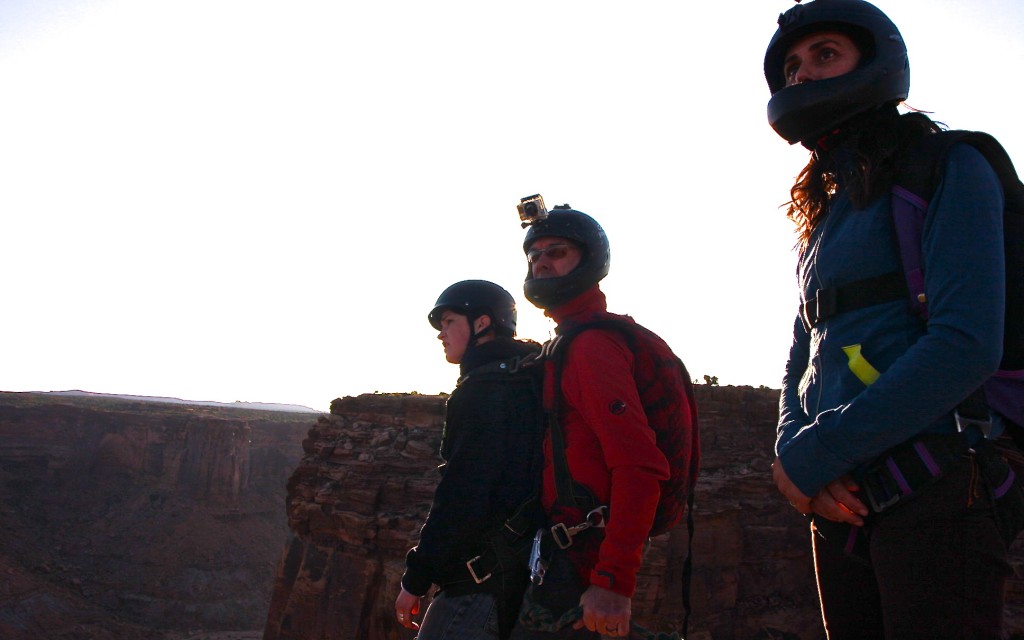04 Dec Tandem BASE Jumping – The Joy Trip Project
The sun rises quickly across the Utah desert. Early morning waves of radiant energy cast long shadows and warm the parched red sand. At dawn near Canyonlands National Park about 35 miles from Moab the air is calm on the rim of Mineral Canyon, a place the locals call “The Sweet Spot.”
Not so sweet was a low pressure system the day before that brought gusting winds. This made things “complicated,” according to our guides, the pro-athlete husband-and-wife team of Mario Richard and Steph Davis. But as luck would have it a window opened—from first light until about 9 a.m. the conditions turned perfect for BASE jumping.
Or so they tell me. With no training or experience in hurling myself off a 900-foot cliff I leave details like weather up to the experts—through their business Moab B.A.S.E. Adventures (moabbaseadventures.com), Davis and Richard offer rank beginners, anyone with nothing more than cash and guts the chance to become a BASE jumper for a day. Strapped to one of the pair, of course. Using rigs perfected in the sport of skydiving the couple now offers tandem BASE jumping among a suite of truly big-air guide services for thrill seekers.
It’s hardly a leap of faith. When it comes to parachutes, Richard is one of the leading aerialists on the planet. And Davis, a world-class expedition rock climber and wing-suit pilot, has racked up 20 years of experience working high above the ground. They are, however, the first company to offer complete novices the chance to jump off cliffs.
Typically it takes months or even years to make that first BASE jump, not to mention thousands of dollars in airplane rides and instruction. But for $399 an average person of moderate fitness can give it a try, jumping tandem. When it comes down to it, it doesn’t take much to jump off a cliff strapped to another human being.
“We’re going to move together to the cliff edge and then take one step and start falling,” Richard says. “We’re climbing over a 12-foot hurdle where you might need a certain physical capacity. If you can walk you can jump off a cliff.”
Three weeks away from her 25th birthday Prudence Meunier meets Richard and Davis just off a dirt road leading into Canyonlands. Dressed in action causal she and a few friends make a long scramble over sand and scrub grass to the rim.
“I was just reading the local paper and I saw the picture,” said Meunier, a massage therapist from Colorado Springs. “People actually do this? I’ve got to try it!”
The Sweet Spot is a flat expanse of sheer exposure, an appropriately steep sandstone cliff high above the Green River. It’s where many aspiring BASE jumpers with far more skydiving experience than Meunier take their first dive to the Earth. After signing a comprehensive liability waver Meunier straps on a helmet and then straps herself to Richard’s chest. After a few basic instructions and words of encouragement, she’s ready to go.
Tethered with a safety line Meunier and Richard shuffle slowly to the edge, a single step from oblivion. “You ready to jump?” he asks with a thumps-up. “Ready to jump,” she replies returning the gesture. Richards unclips the safety line. Rope and carabiner clank to the ground. Together they counted. “Three, two, one and jump!”
Their free-fall lasts only a quarter of a second. The parachute deploys with a report like a rifle blast. A bright yellow and red canopy unfurls as client and guide float slowly safely to the canyon floor. Another novice has taken the plunge.
There are some considerations. Richards does insist that his clients don’t exceed his own weight of 185 pounds. And he prefers to work with those who aren’t too much taller than he is. With a relatively short distance to fall It’s important to select a cliff that’s as steep as possible to avoid the unseemly possibility of hitting the wall on the way down.
“Something as simple as that can affect the safety of the jump,” Davis says. “There’s always risk but that’s one way to mitigate that risk.”
Once safely back to earth Meunier is giddy with delight, but she admits this is hardly the beginning of a long career as a BASE jumper.
“I do things once and that’s it,” she says. “It was a great experience. It takes your breath away.”
At its core that’s really what tandem BASE jumping is all about. It can either be an introduction to a new sport or a one-time opportunity to do something infinitely cool.
“The passenger is there to live something intense without having to go through all the prerequisites,” Richard says. “We put them in the fast lane and say ‘I’m going to take you for a ride’.”
This story originally ran in the September issue of Elevation Outdoors Magazine
The Joy Trip Project is made possible with the support sponsors Patagonia, Rayovac and the New Belgium Brewing Company
![]()
![]()





You must be logged in to post a comment.